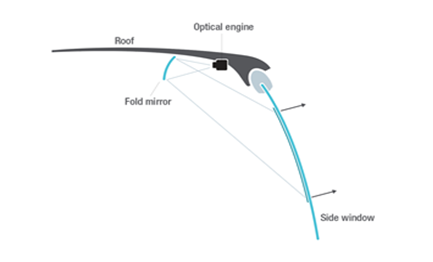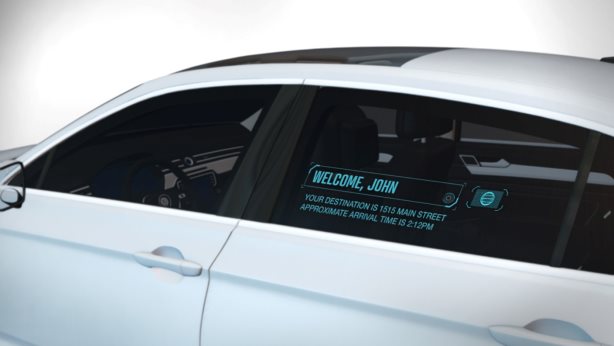Nowadays, drivers can communicate with other drivers and pedestrians in a variety of ways, including using lights and gesturing. But what if the car is unmanned?
With the rise of autonomous vehicles, the signal that drivers transmit valuable vehicle information to other drivers and pedestrians needs to be further expanded to facilitate better communication between cars and pedestrians. Driverless cars will need more efficient ways to communicate information and intentions, and display technology will be a key interface for communication between vehicles and surrounding vehicles and pedestrians.
At present, there are many types of displays on the car, but few show the ability to communicate with the surrounding environment. A transparent window display may become the corresponding solution. There are a number of reasons why the transparent window display technology can further enhance the performance of the vehicle so that the driver, pedestrian and cyclist of any vehicle on the road can understand the vehicle's indication when sharing the road with the self-driving car.
Signal signs will be everywhere
Traffic signals have a long history, with the earliest gestures and wooden signs. With the development of the city center, traffic lights have also proliferated in response to more cars, buses, pedestrians and cyclists who need to “communicate” with each other. However, what is the communication between different drivers or between drivers and pedestrians?
For nearly a century, we have seen the car's signal evolved from a gesture signal to an optical signal. The turn signal has become a term that is known to today's drivers. When the lights are flashing, everyone can understand the driver's intentions.
So far, the driver has to signal by manually turning on the flash. However, as more and more modern vehicles are equipped with sensors to feed the Advanced Driver Assistance System (ADAS), these sensors can automatically generate an intent signal so that the driver does not have to manually send the signal. Even today's cars and buses have these features, but sometimes communication can be attributed to eye contact and gestures, such as waving to pedestrians on a crosswalk, something that driverless cars can't.
The arrival of driverless cars and autonomous buses means that we not only expand the signals that cars use to deliver intent, but also expand the surface that cars use to deliver information. For example, the use of a digital display can enable a driverless car to clearly indicate that a pedestrian is "first". However, attaching an external sign to an ordinary car at multiple locations adds a lot of complexity - from taking up the vehicle's exterior space to increasing the number of wires in the entire vehicle.
The good news is that vehicles can now use multiple surfaces, such as windows that can be used to display intent. Projection display technology adapted to the automotive industry in combination with new transparent films allows for a variety of communication options to be available using existing vehicle windows. Because these new displays are able to show the driver, pedestrians and cyclists through the window, we are able to adapt to driverless cars.
Transparent window display technology is about to be used in lanes
Transparent display solutions for the automotive industry have the potential to solve communication problems caused by driverless cars by displaying detailed images and text on the window surface, for example, whether it is a day or night signal Seen by other drivers and pedestrians.
As shown in Figure 1, the key information can be displayed using the window by installing a small car-level projector in the side window, rear window or front window. The transparent film material embedded in the window layer can display information to the driver, cyclist or pedestrian.

Figure 1: Schematic diagram of a projector-based transparent window display setup
Projector-based technology has been used to improve the driving experience. This technology powers the augmented reality (AR) head-up display (HUD) by displaying information on the windshield, allowing the driver to focus on the road as a key message.
Now, the same optical technology can display the existing window infrastructure as needed, but it is still a fully functional window if not needed. From an aesthetic point of view, you can still have a beautifully looking car, and from a power point of view, you don't need to keep the display device running.
lluminate the road ahead
The transparent window shows that the most likely application to achieve is very simple, which is to share information with other drivers and pedestrians to enhance the current signal. In addition, there are many possibilities. For example, before the popularity of autonomous vehicles, transparent window displays can enhance today's signal technology and gestures while delivering information.
The taxi service is most likely to be the first to experience a transparent window display, and the window display allows passengers to clearly know that their car is coming.

Buses also have a lot of information to share, and their intentions can be shared with other vehicles on the road, vehicles at bus stops, and existing passengers on the bus, such as the details of the next stop on the route, or the point on the rear windshield. Bright parking sign. Transparent window displays can also be an important communication channel for communicating weather alerts and other emergency notifications.
In addition to sharing travel and intent information, buses and taxis can display dynamic advertisements that are easier to change than static displays that use windows as a medium. These next-generation advertising displays are not only easy to program, but also increase the revenue-generating capacity by using the vehicle's GPS data to deliver more advertisements to people in a particular area, which can benefit new passengers sharing a given vehicle. Advertising can also be delivered to car owners to create more revenue sources by placing travel information and infotainment on taxis and hotel and airport shuttles.
And the fact is that robot taxis and automatic buses are not far from us. Once an unmanned vehicle begins to land, we must expand the language that conveys intent between the driver, pedestrian and cyclist to maintain optimal traffic flow and safety. Transparent window displays provide a powerful, non-intrusive way to enhance the performance of today's vehicles and enable future vehicles to deliver intent—even when the car is unmanned.
0 Comment(s)